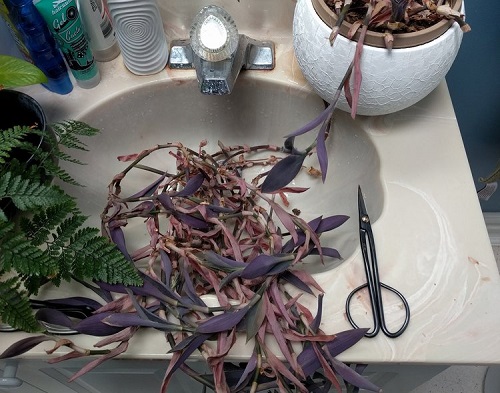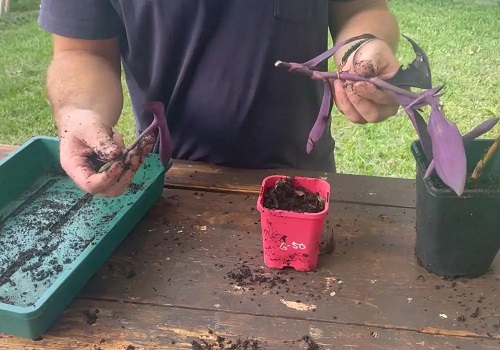Learn Propagating Purple Heart in 5 Simple Steps and add a touch of vibrancy to your houseplant collection!

Purple Heart, also known as Tradescantia pallida, is a vibrant houseplant prized for its vibrant purple leaves and delicate pink flowers. If you want to expand your indoor garden with more of this beauty, here’s a comprehensive guide on Propagating Purple Heart in 5 Simple Steps!
Elevate The Beauty Of Your Plant Collection with these Purple Flowers
Best Time To Propagate Purple Heart

The best time to propagate Purple Heart is late spring or early summer. The plant is in its active growth phase during this period, and the weather conditions are typically mild. Propagating Purple Heart at this time allows the cuttings to root more efficiently and provides them with the ideal environment to thrive.
Warm temperatures and consistent daylight stimulate root development, while the plant’s natural growing cycle supports healthy establishment.
Check out some Elegant Purple Houseplants here
Things You’ll Need
Take note of the must-haves for healthy Purple Heart Propagation:
- Sharp Sterilized Scissors or Pruning Shears: Ensuring a clean cut will promote healthier growth.
- Pot with Drainage Holes: Good drainage is key to preventing root rot.
- Quality Potting Mix: A mix with good aeration promotes root development.
- Rooting Hormone (Optional): This can stimulate faster root growth.
Propagating Purple Heart in 5 Simple Steps

Step #1: Selecting the Cutting
Find a healthy Purple Heart plant with robust stems and vibrant leaves, and choose a stem at least a few inches long with multiple leaves. Using a sharp, sterile pair of gardening scissors or a knife, cut the stem at a 45-degree angle just below a leaf node.
Healthy and disease-free leaves are a must; the stem should be neither too young nor too woody.
Pro Tip: The best time to take a cutting is in the morning when the plant is fully hydrated.
Step #2: Preparing the Cutting
After obtaining the cutting, carefully remove the leaves from the lower part of the stem, leaving at least one or two leaves at the top. Allow the cut end to dry for a few hours to prevent rotting. You may also dip the cut end of the stem in a rooting hormone, brushing off excess.
Step#3: Rooting the Cutting
Fill a small pot with a mix of potting soil and sand or a commercial rooting medium. Insert the cut end of the stem into the soil, burying the leaf node in the soil, and water the cutting lightly, keeping the soil moist but not soggy.
Alternatively, you may also dip the cutting in a glass of clean chlorine-free water. Ensure to change the water every 2-3 days or when the color changes.
Step#4: Growing the Cutting
Keep the pot in a bright, indirect light location and avoid direct sunlight, which can scorch the young plant. Watch for new growth as a sign of successful rooting, usually within a few weeks, and maintain consistent moisture without overwatering.
Pro Tip: A temperature between 65-75°F and humidity levels around 50-60% will foster healthy growth.
Step#5: Transplanting the New Plant
Once the cutting has established roots and grows new leaves, it can be transplanted. Choose a spot with well-draining soil and partial to full sun. Grow it in a hanging basket to let the vibrant leafy stems dangle in style.
In case of water propagation, transplant the cutting to a well-draining potting mix and let it acclimate to the indoor surroundings for a few days before exposing it to sunlight.
Alternative Propagation Techniques

Here are a few alternative Purple Heart Propagation techniques:
Layering
- Preparation: Select a healthy, long stem still attached to the mother plant.
- Bending: Bend it down to the soil surface without cutting it from the mother plant and pin it using a U pin
- Planting: Bury that section of it in the soil while still attached.
- Rooting: Allow roots to grow from this section, then cut from the mother plant.
Division
- Preparation: Gently remove the plant from the soil during repotting.
- Separation: Divide the root ball into sections, each with some roots and foliage.
- Planting: Plant each division into a new pot with well-draining soil.
Growing From Seeds
- Preparation: Collect seeds from the mature plant or purchase them.
- Planting: Sow the seeds in a seed-starting mix and cover lightly.
- Germination: Keep the soil moist and place it in a warm, bright location.
Quick Care Tips

- Light Requirements: This plant thrives in bright, indirect sunlight. Place it near a bright window but shielded from direct rays. A few hours of morning sun can be beneficial but avoid harsh afternoon sunlight.
- Water Care: Water the plant when the top inch of the soil feels dry. Water enough to moisten the soil without waterlogging it, allowing the top layer to dry out between waterings. During winter, reduce watering to prevent root rot, as the plant’s growth slows down.
- Soil Needs: Use well-draining soil rich in organic matter, with a pH of 6.0-7.0. A mixture of 2 parts potting soil, 1 part sand or perlite is often ideal. Choose a container with ample drainage holes to prevent water retention and root rot.
- Fertilizer Requirements: Utilize a balanced, liquid fertilizer, like a 10-10-10 or 14-14-14 formulation, applying every four to six weeks during the growing season. Follow the manufacturer’s guidelines, usually about 1 tablespoon per gallon of water for outdoor plants and half for indoor ones. Over-fertilizing can lead to salt build-up, so occasionally flush the soil with plain water to mitigate this.
- Temperature and Humidity: A temperature range of 60-80°F (15-27°C) is optimal, avoiding anything below 50°F (10°C). Moderate humidity levels around 40-50% are perfect for healthy growth. Grouping plants or using a humidity tray can help maintain moisture levels indoors.
- Other Care Standards: Pruning by trimming back the stems encourages bushier growth. Watch for aphids and other pests, and treat them with neem oil solution or insecticidal soap.






